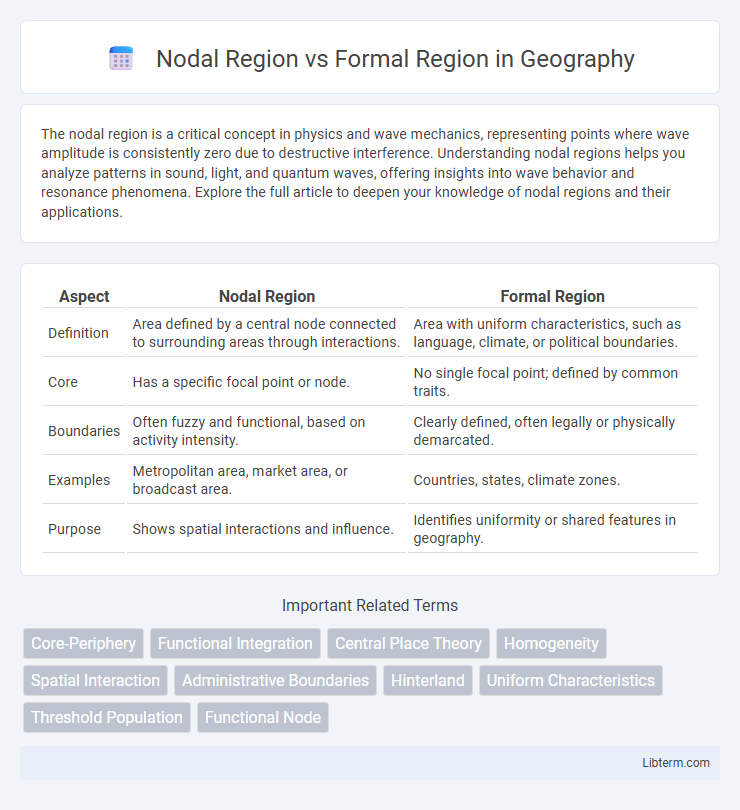The nodal region is a critical concept in physics and wave mechanics, representing points where wave amplitude is consistently zero due to destructive interference. Understanding nodal regions helps you analyze patterns in sound, light, and quantum waves, offering insights into wave behavior and resonance phenomena. Explore the full article to deepen your knowledge of nodal regions and their applications.
Table of Comparison
| Aspect | Nodal Region | Formal Region |
|---|---|---|
| Definition | Area defined by a central node connected to surrounding areas through interactions. | Area with uniform characteristics, such as language, climate, or political boundaries. |
| Core | Has a specific focal point or node. | No single focal point; defined by common traits. |
| Boundaries | Often fuzzy and functional, based on activity intensity. | Clearly defined, often legally or physically demarcated. |
| Examples | Metropolitan area, market area, or broadcast area. | Countries, states, climate zones. |
| Purpose | Shows spatial interactions and influence. | Identifies uniformity or shared features in geography. |
Introduction to Nodal and Formal Regions
Nodal regions are defined by a central point or node where the surrounding areas are functionally connected through transportation, communication, or economic activities, often measured by the intensity of interactions radiating from the core. Formal regions exhibit homogeneity in one or more physical or cultural traits, such as climate zones, language areas, or political boundaries, and are characterized by clearly defined, measurable attributes. Understanding nodal and formal regions is essential in geography to analyze spatial organization and regional characteristics based on connectivity and uniformity.
Defining Nodal Regions
Nodal regions are defined by a central point or node, such as a city or transportation hub, with surrounding areas connected through social, economic, or functional ties. These regions emphasize interactions, communication, and the flow of goods or services radiating from the node. Unlike formal regions, nodal regions lack uniform characteristics and are shaped by the intensity of relationships centered on the node.
Characteristics of Nodal Regions
Nodal regions are defined by a central node or focal point that connects surrounding areas through various interactions such as transportation, communication, or economic activities. These regions are characterized by functional unity, where the strength of connections diminishes as distance from the node increases. Examples include metropolitan areas centered around a city or radio broadcast zones focused on a transmission tower.
Defining Formal Regions
Formal regions are defined by uniformity in specific physical or cultural characteristics, such as climate, language, or political boundaries, that create clear and measurable traits throughout the area. These regions are often established by governmental or administrative standards, making them easily identifiable and consistent for data collection and analysis. Unlike nodal regions, which are organized around a central point of activity or influence, formal regions emphasize homogeneity and official recognition.
Characteristics of Formal Regions
Formal regions are defined by uniform physical or cultural characteristics such as climate, language, or political boundaries, making them distinct and easily identifiable. These regions exhibit clear, consistent features that separate them from surrounding areas, often governed by official administrative units like countries, states, or cities. The homogeneity within formal regions facilitates statistical analysis and policy-making based on shared attributes.
Key Differences Between Nodal and Formal Regions
Nodal regions are defined by a central point or node that serves as a focal hub for economic, social, or functional activities, such as a metropolitan area centered around a city. Formal regions, also known as uniform or homogeneous regions, are characterized by consistent physical or cultural traits, like language, climate, or political boundaries, that are uniform throughout the area. The key difference lies in nodal regions being organized around a central node and its influence, while formal regions exhibit uniformity across all parts without reliance on a focal point.
Examples of Nodal Regions
Nodal regions, also known as functional regions, are defined by a central hub and the surrounding areas connected to it through various interactions, such as communication, transportation, or economic activities. Examples of nodal regions include metropolitan areas like New York City, where the city serves as the central node for finance, media, and culture, influencing surrounding suburbs and smaller towns. Radio broadcast areas or airline hubs also exemplify nodal regions, as their reach and services center around a key location impacting adjacent regions.
Examples of Formal Regions
Formal regions are defined by uniform characteristics such as language, climate, or political boundaries, exemplified by the Sahara Desert characterized by its arid climate, the French-speaking province of Quebec marked by its official language, and the political boundaries of Texas as a U.S. state. These regions exhibit a high degree of homogeneity in specific attributes, distinguishing them from nodal regions, which are organized around a focal point or node and characterized by functional connections like a metropolitan area centered on a city. Understanding formal regions helps in analyzing spatial uniformity and categorization based on tangible criteria.
Importance of Regional Concepts in Geography
Nodal regions, defined by specific focal points such as cities or hubs, illustrate how economic and social activities are organized around central nodes, emphasizing interconnectedness in geography. Formal regions, characterized by uniform physical or cultural features, provide clarity in spatial analysis by delineating areas with shared attributes critical for resource management and policy-making. Understanding these regional concepts is essential in geography for interpreting human-environment interactions, planning regional development, and addressing spatial disparities effectively.
Applications of Nodal and Formal Regions in Real Life
Nodal regions, defined by a central node and surrounding areas connected by interactions such as transportation or communication, are crucial in urban planning for optimizing transit systems and service delivery networks. Formal regions, characterized by homogeneity in physical or cultural traits, support policy-making and resource allocation by delineating areas with common economic activities or climate zones. Understanding these regions enhances geographic analysis, enabling efficient management of infrastructure and tailored regional development strategies.
Nodal Region Infographic

 libterm.com
libterm.com